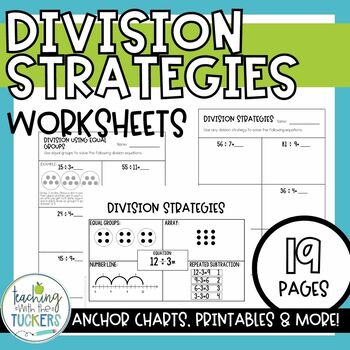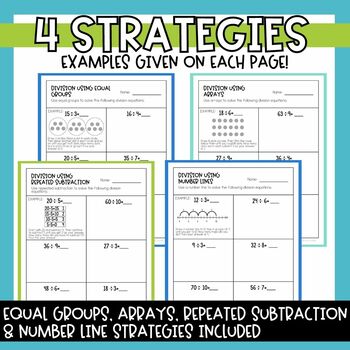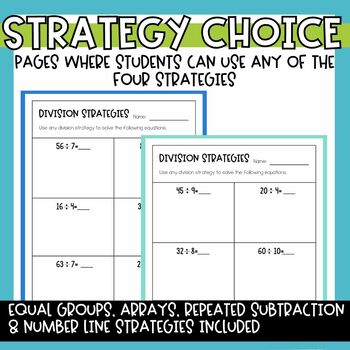Division Strategies Worksheets: Arrays, Number Line, Equal Groups
Teaching with the Tuckers
117 Followers
Grade Levels
2nd - 4th
Subjects
Resource Type
Standards
CCSS3.OA.A.2
CCSS3.OA.A.3
CCSS3.OA.C.7
Formats Included
- PDF
Pages
20 pages
Teaching with the Tuckers
117 Followers
What educators are saying
Used this resource as part of the students homework packets. Loved the examples provided for students to reference at home.
This was perfectly aligned with our standards and allowed me to have my students show me what they understood.
Description
Help students learn how to use different division strategies with these engaging division worksheets. These worksheets include division using arrays, number lines, repeated subtraction, and equal groups. Help students get division practice no matter what level they are on or what strategy they are focusing on.
This Division Strategies Worksheet Packet includes:
- 2 pages of large anchor charts displaying 4 strategies for solving division (arrays, equal groups, repeated subtraction, and number line). One is filled out for you, the other is blank to use for solving different division equations.
- 2 pages of smaller student anchor charts. These are the same version of the larger teacher version including one that is filled out and one that is blank.
- 3 worksheet pages of division using equal groups
- 3 worksheet pages of division using arrays
- 3 worksheet pages of division using repeated subtraction
- 3 worksheet pages of division using number lines
- 2 worksheet pages of using any division strategy to solve the equations
- 1 worksheet page of using all 4 division strategies to solve equations. This page leaves the equation box blank so that you can change the equation for your students as needed.
- Total of 19 pages for you to use!
Total Pages
20 pages
Answer Key
N/A
Teaching Duration
N/A
Report this resource to TPT
Reported resources will be reviewed by our team. Report this resource to let us know if this resource violates TPT’s content guidelines.
Standards
to see state-specific standards (only available in the US).
CCSS3.OA.A.2
Interpret whole-number quotients of whole numbers, e.g., interpret 56 ÷ 8 as the number of objects in each share when 56 objects are partitioned equally into 8 shares, or as a number of shares when 56 objects are partitioned into equal shares of 8 objects each. For example, describe a context in which a number of shares or a number of groups can be expressed as 56 ÷ 8.
CCSS3.OA.A.3
Use multiplication and division within 100 to solve word problems in situations involving equal groups, arrays, and measurement quantities, e.g., by using drawings and equations with a symbol for the unknown number to represent the problem.
CCSS3.OA.C.7
Fluently multiply and divide within 100, using strategies such as the relationship between multiplication and division (e.g., knowing that 8 × 5 = 40, one knows 40 ÷ 5 = 8) or properties of operations. By the end of Grade 3, know from memory all products of two one-digit numbers.





